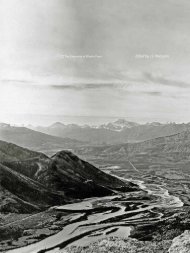C Ihe Ladies c cu. V'VVAN - History and Classics, Department of
C Ihe Ladies c cu. V'VVAN - History and Classics, Department of
C Ihe Ladies c cu. V'VVAN - History and Classics, Department of
- No tags were found...
Create successful ePaper yourself
Turn your PDF publications into a flip-book with our unique Google optimized e-Paper software.
Notes to Page57-17 241in the out-<strong>of</strong>-doors, even though such experience may havebeen gained no further afteld than the Adirondacks or thewoods <strong>of</strong> Maine <strong>and</strong> it has been accomplished winter <strong>and</strong>summer by hundreds <strong>of</strong> travellers since the country was ftrstopened up by white men. Many white women have made thejourney <strong>and</strong> more than one sick person has been carriedacross the mountains to where, in earlier days, the nearestsuccour could be obtained. The trails followed may almostbe called commercial highways, for they have been used bytraders, prospectors <strong>and</strong> explorers for a century past. Withthe establishment <strong>of</strong> steamboat transportation on theYukon <strong>and</strong> Mackenzie Rivers <strong>and</strong> the decline <strong>of</strong> the goldminingindustry with its constant drift <strong>of</strong> prospectors to<strong>and</strong> fro, the trail has ceased to be an essential commerciallink <strong>and</strong> the amount <strong>of</strong> travel passing over it today is but afraction <strong>of</strong> that <strong>of</strong> former years. Nevertheless, there is stillsufficient movement back <strong>and</strong> forth <strong>of</strong> natives <strong>and</strong> occasionalwhite men to keep the memory <strong>of</strong> the trail alive <strong>and</strong>no diffi<strong>cu</strong>lty will be found in obtaining Indians perfectlycompetent to conduct a party across the divide on anyroute. Indeed, the l<strong>and</strong>marks <strong>and</strong> trail signs are such thatany experienced traveller could dispense with guides,though such a course is not recommended. And as not theleast important function <strong>of</strong> so-called guides is that <strong>of</strong> doingall the manual work <strong>of</strong> the trip, the paddling, tracking,camp-making, etc., in such capacity alone their services aredesirable <strong>and</strong> they are worthy <strong>of</strong> their hire. (Warner, "Fromthe Mackenzie" I, 2)CHAPTER 3: SOUTHAMPTON TO EDMONTON(15-27 MAY)Vyvyan's fteld notes commence with the entry starting thischapter, slightly edited for publication. The chapter emphasizesthe women's strong characters more than the fteld notesdo at this point: Dorrien Smith's indignation at the shipboardmedical inspection <strong>and</strong> Gordon Mactavish's tale <strong>of</strong> missing thewomen at the Winnipeg train station because their apparentcertainty belied the possibility that they could be strangers tothe city do not appear in the fteld notes, nor do the field notesemphasize the women's public notoriety to the same extent asthe book."without forDl <strong>and</strong> void"This is a quotation <strong>of</strong> Genesis 1:2.CHAPTER 4: OUTFITTING IN EDMONTON(27 MAY-1 JUNE)The reference to the prospect <strong>of</strong> eating goose during the canoetrip has no corresponding entry in the field notes <strong>and</strong> seemsdeSigned only to foreshadow the dinner described in Chpt 15.Generally, this chapter follows the field notes' depiction <strong>of</strong>Edmonton-rather unimpressive in comparison to Winnipeg,where the women had enjoyed a gUided whirlwind tour whilethe transcontinental train paused for twenty-four hours. Thiscontrast might be accounted for by the women's knowing noone in Edmonton, in their having to spend time shopping forsupplies <strong>and</strong> attending to the logistics <strong>of</strong> a northern itinerary(activities that evidently appealed to neither woman), <strong>and</strong>simply corning to another prairie city still without beginning tohead north-after all, they had no "wilderness" experience toshow for their eighteen days (14-31 May) <strong>of</strong> travel. Included inAmerican Fullerton Waldo's six articles <strong>and</strong> one book about histravels north <strong>and</strong> down the Mackenzie in 1922 is a verydifferent view <strong>of</strong> Edmonton, one that includes, if fulsomely, ahigh regard rather than rebuke for its citizens' optimism (Down1 -22).EdDlontonBy 1926, Edmonton had been known for three decades as theGateway to the North, thanks largely to those who travelled tothe Klondike by way <strong>of</strong> the city during the gold rush in the lastyears <strong>of</strong> the nineteenth century. According to the DominionCensus <strong>of</strong> 1926, the city's population was 65,163 that year,having shot up from only a fifth <strong>of</strong> that just two decades earlier.It was a burgeoning regional centre for agri<strong>cu</strong>lture, but alsohad served the entire near North <strong>and</strong> western Arctic from asearly as the last decade <strong>of</strong> the eighteenth century. Then, theHBC, as part <strong>of</strong> its foray into the Eldorado <strong>of</strong> the Athabascadistrict, established posts on the North Saskatchewan River inthe vicinity <strong>of</strong> the present-day location <strong>of</strong> the city. The moresouthern post was to provide reliable supplies <strong>of</strong> pemmican(made from pounded, dried buffalo meat, unobtainable inlarge quantities farther north) to permit brigades <strong>of</strong> voyageursto complete long-distance return trips by canoe to Hudson Bay
















